Manure storages for small- to medium-size horse farms
Learn why it’s important to properly store horse manure, and how to construct an ideal horse manure storage for up to 10 horses. This technical information is for Ontario horse owners.
ISSN 1198-712X, Published June 2020
Introduction
There are an estimated 325,000 horses on about 53,000 Ontario farms — an average of six horses per farm.
Many horse owners do not consider the need to handle and store their manure and often view it as a waste and nuisance rather than a resource. They are afraid of introducing, or recycling, intestinal parasites and/or weed seeds by applying the manure on their pastures — a valid concern, since many horse owners pile their manure without encouraging the proper composting that would kill parasites and seeds.
Improperly handled horse manure can also affect the quality of surface water and groundwater because it contains phosphorus, nitrogen and pathogens, just like other livestock manures (Figure 1).
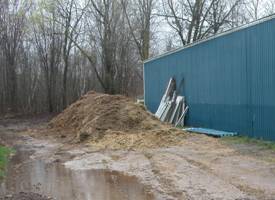
The ideal horse manure storage should be simple yet effective, labour-efficient and cost-effective. It should prevent contamination of surface water and groundwater, encourage proper composting and make the manure more useful for crop production.
This factsheet will help you understand the need for correct horse manure storage and explain how to construct an ideal horse manure storage for up to 10 horses.
Familiar problems
If you agree with some, or all, of the following statements about manure at your horse farm, consider constructing a manure storage:
- I think horse manure is more environmentally friendly than other manure types.
- I see juices running away from my horse manure. I see flies and smell odours around it.
- I’m concerned about parasites and/or weed seeds, so I don’t spread manure, and my pile is growing.
- The manure broker I hire to truck my manure has to “chase” it around the yard in order to pick it up.
- It is really tricky transporting my manure by wheelbarrow from the horse barn to the pile.
- I want to do my part to protect water quality, but I’ve heard constructing storages can be expensive.
Let’s look at how to address some of these issues with the construction of your ideal horse manure storage.
Horse manure – environmentally friendly
Agrisuite is a software tool that helps farmers determine suitable nutrient application rates for current and future crops. The database contained in Agrisuite, a software program produced by the Ontario Ministry of Agriculture, Food and Rural Affairs (OMAFRA), inventories the manure nutrient contents of many kinds of Ontario livestock manures collected over the years.
There are almost 2,800 dairy manure samples in the NMAN database, but only 41 samples of Ontario horse manure, even though there are almost as many horses in Ontario as dairy cows.
Agrisuite contains a program called MSTOR that uses information about livestock manure volume production to determine how much manure needs to be stored, based on the type and size of production system. Table 1 shows Ontario information about horses
| Characteristic | One adult horse |
|---|---|
| Weight (medium-sized horse) | 454 kg (1,000 lb) |
| Nutrient units under the Nutrient Management Act | 1 nutrient unit (1 NU) |
| Volume of solid manure & bedding produced per day | 0.04 m3 (1.42 ft3) |
| Volume of solid manure & bedding produced per year | 14.7 m3 (519 ft3) |
| % dry matter | 23%–63% (36% average) |
| % N (nitrogen) | 0.22%–0.9% (0.5% average) |
| % P (phosphorus) | 0.05%–0.4% (0.15% average) |
| % K (potassium) | 0.1%–1.0% (0.4% average) |
| NH4-N (ppm) (fresher manure has a higher level) | 10–2,800 (637 average) |
| Carbon/nitrogen (C:N) ratio | 12:1 to 63:1 (30:1 average) |
| Organic matter | 19%–62% (26% average) |
| Typical beddings used | Shavings, peat, sawdust, straw |
A 454-kg (1,000‑lb) horse produces about 2.0 tonnes (2.2 tons) of manure/year, including bedding. So, the average farm with six horses would produce a manure pile every year that would completely fill a large room, 6 m x 6 m x 2.4 m high (20 ft x 20 ft x 8 ft). Imagine how large a manure pile 325,000 horses would create!
The nutrient content of horse manure is comparable to beef manure containing bedding. Horse manure contains pathogens like other manures. So, nutrients and pathogens contained in runoff from horse manure piles could cause environmental issues if allowed to flow to surface waters via ditches or tile drains, or to groundwater via shallow bedrock or coarse soils under a manure pile.
Rules for manure in Ontario
There are rules for the storage and handling of livestock manure in the Nutrient Management Act, 2002 (NMA), and Ontario Regulation 267/03. See OMAFRA nutrient management or contact the Agricultural Information Contact Centre at
You fall under NMA rules if:
- you currently have 300, or more, medium-sized horses housed simultaneously on your “farm unit” (uncommonly large horse farm by Ontario standards)
- you’re applying for a building permit to build a new horse barn or manure storage or expand an existing horse barn or manure storage and you will have more than 5 NU (e.g., 6 or more medium-sized horses) when the project is complete
Check with your municipality to determine if a building permit is required for your manure storage. Typically, permits are required for structures with high walls, roofs or specialized construction needs due to structural concerns (Figure 2).
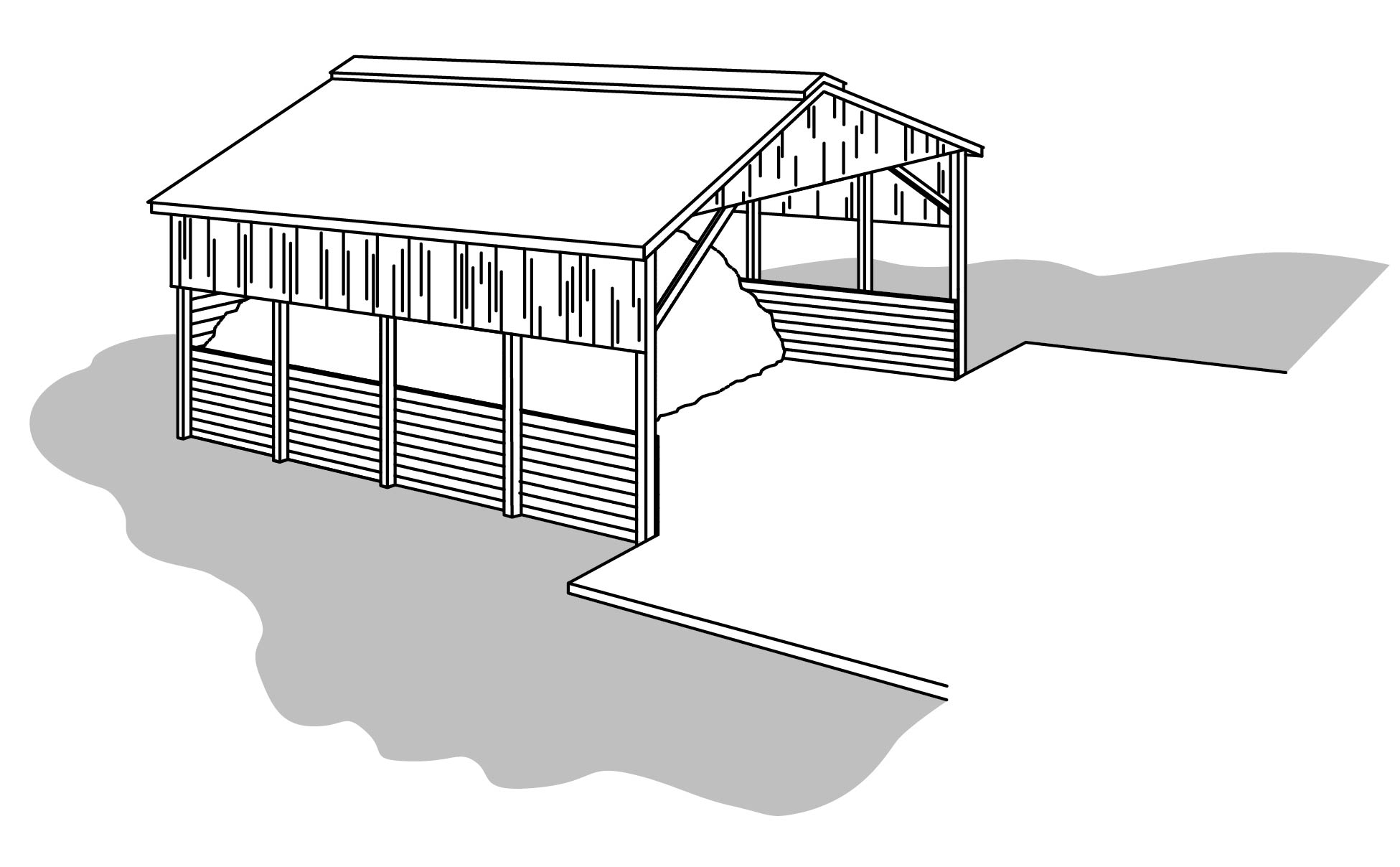
The need for engineered design of the small horse manure storages described in this factsheet is waived if these storages meet all the following criteria:
- volumes less than 600 m3 (21,189 ft3)
- floor areas less than 600 m2 (6,458 ft2)
- wall heights 1 m (3.28 ft) or less. (Note: walls must be 1 m or less, but the manure can be stored as deep as is practical)
There are siting restrictions for storages phased-in under the NMA, but it also is a best management practice to meet, or exceed, these minimum setbacks:
- 15 m (50 ft) away from any field tile drains
- 15 m (50 ft) away from a drilled well
- 100 m (328 ft) away from a municipal well
- 30 m (100 ft) away from any other wells
- 50 m (164 ft) flowpath away from surface waters or tile inlets such as catch-basins
Storage to reduce odours, flies and runoff
There is no guarantee a storage will stop all odours, flies or runoff from manure, but one can help. Odours are produced from manure when conditions in the pile, such as very wet, tightly packed manure, are allowed to become anaerobic — decomposing in the absence of oxygen. Aerobic conditions (when oxygen is present) produce fewer bad odours. Conditions in a pile of manure behind your barn might be aerobic near the top of the pile where water drains away from it, but anaerobic at the lower edges of the pile where the runoff water remains.
Ontario research demonstrated that runoff occurs from the sloped sides of a pile of manure
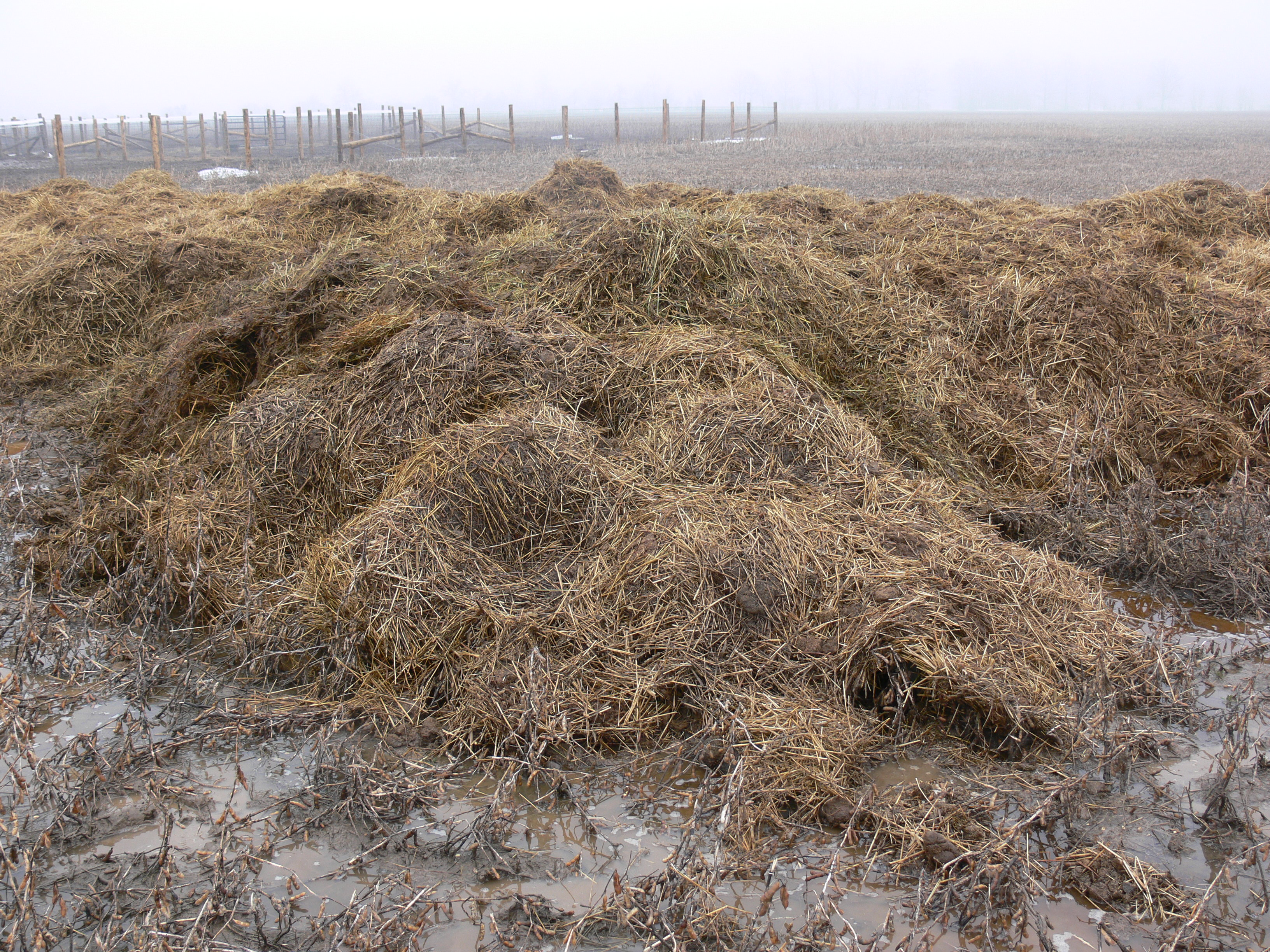
Flies need food, moisture, optimum temperatures and a place to hide in order to breed and proliferate. The conditions are perfect for this inside a damp manure pile. If the pile is dry, flies are kept to a minimum.
Spreading manure on pasture – weeds and parasites
If your horse manure is encouraged to properly compost, temperatures in the pile will reach levels high enough to kill parasites, weed seeds and even fly larvae. Ideally, maintain a core temperature in the manure pile of 55°C for 15 days. During composting, micro-organisms, such as bacteria and fungi, break down organic material into a stable, dark brown, soil-like material. This process requires a proper balance of carbon, nitrogen, oxygen, moisture and temperature.
Horse manure composts naturally with the mixture of carbon in the bedding, nitrogen in the manure and oxygen, as it is bulky. The ideal carbon to nitrogen (C:N) ratio is from 25:1 to 35:1, and ideal dry matter content is 40% to 60% (much like a damp sponge after the water is wrung out). The C:N ratio and dry matter content can only be known by lab analysis, however, Table 1 shows that most horse manures are close to the ideal ranges. Heat is produced during composting, but the process slows if the air is too cold.
Manure storage assists composting since the piles are more compact, especially with walls to help retain heat in winter. Walls promote uniform soaking-in of rainfall, which encourages composting. Periodic turning of the pile, where possible, introduces oxygen. This stimulates biological activity, speeds composting and raises pile temperatures. Turning is easier in a pile with a concrete floor and walls.
Manure brokers
Many horse farmers pay manure brokers to take their manure because they do not have any use for it in crop production (Figure 4). The fee is based on how difficult it is to remove the manure, how many trips are needed, and who is willing to take and use the manure. Some horse farmers get local cash croppers to remove and use their manure. In either case, storage helps reduce removal costs and make horse manure more attractive for others to use since it:
- densifies the manure — since horse manure is so light and bulky, it isn’t cost-effective to transport
- helps retain nutrients, making the manure more useful for crop production
- makes manure removal easier, in any weather, particularly if there is a concrete floor and walls
- makes it easier to estimate volumes for transport

Getting manure from the horse barn and into storage
Most horse farmers use wheelbarrows to move manure from the stalls to storage. If the path is wet, bumpy or narrow, the resulting pile of manure ends up very large and too shallow (1 m deep, or less) as in Figure 3.
The key is to reduce the distance you have to manoeuvre over the surface of the manure and find ways to elevate the manure more easily. You could install a fixed-in-place stable cleaner to elevate the manure, but this is expensive.
Here are some ideas to consider:
- construct the storage so there is access from all sides at an elevated level using soil backfilled against the outside of the walls (Figure 5)
- construct the storage into the side of a hill that is below the level of the barn (Figure 6)
- purchase a simple portable belt conveyor that moves manure some distance and to higher levels in the storage (Figure 7)
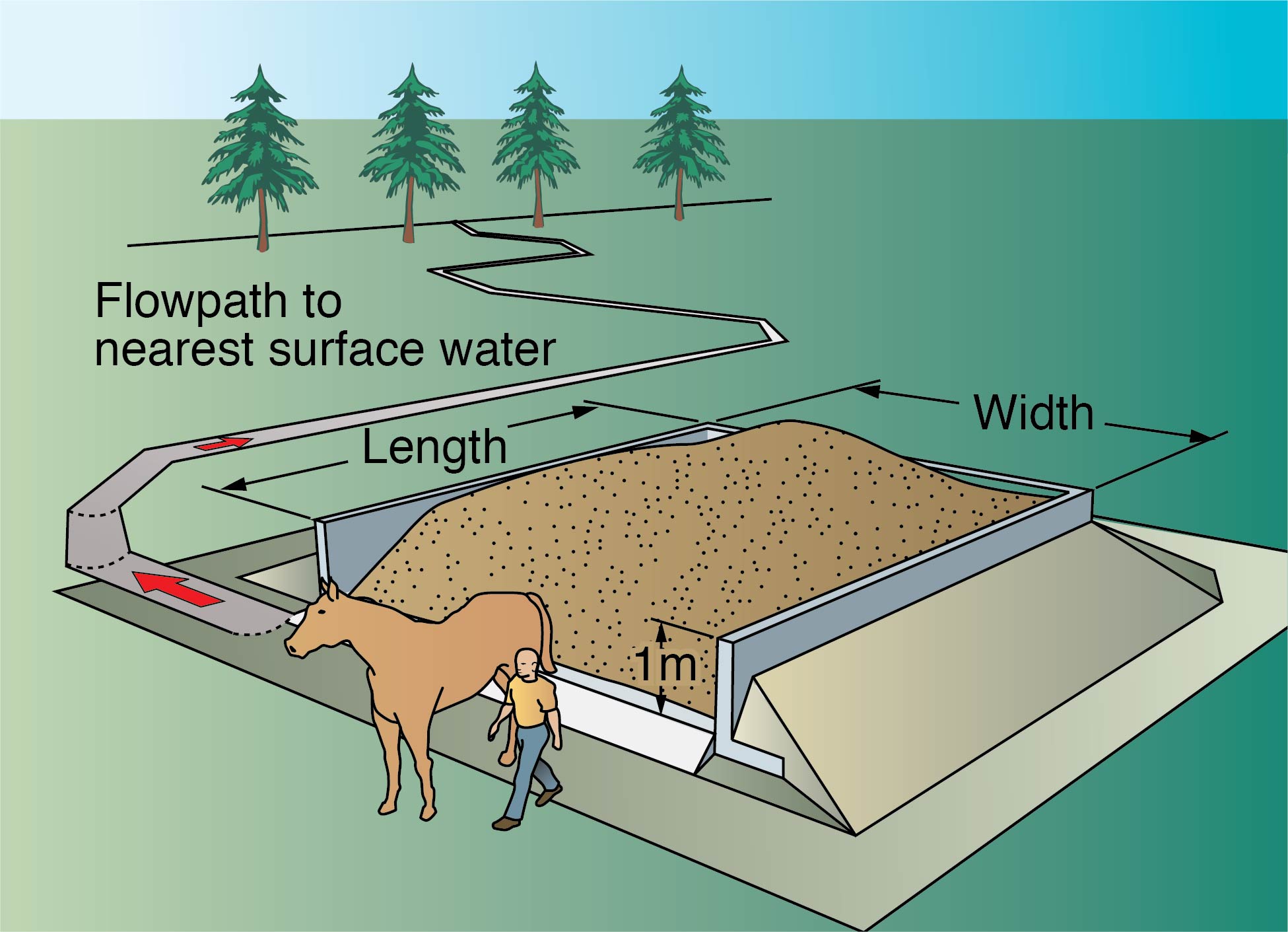
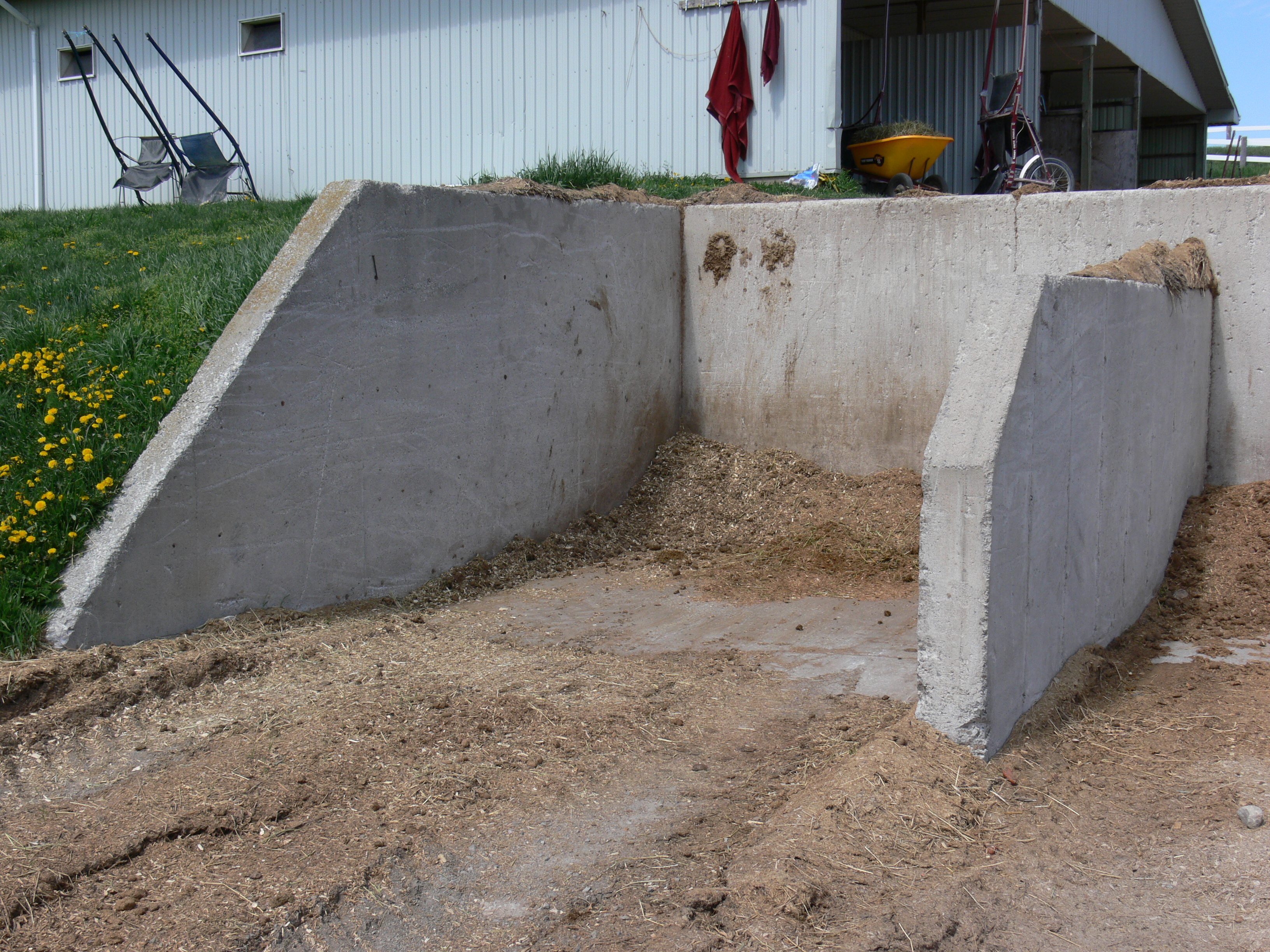
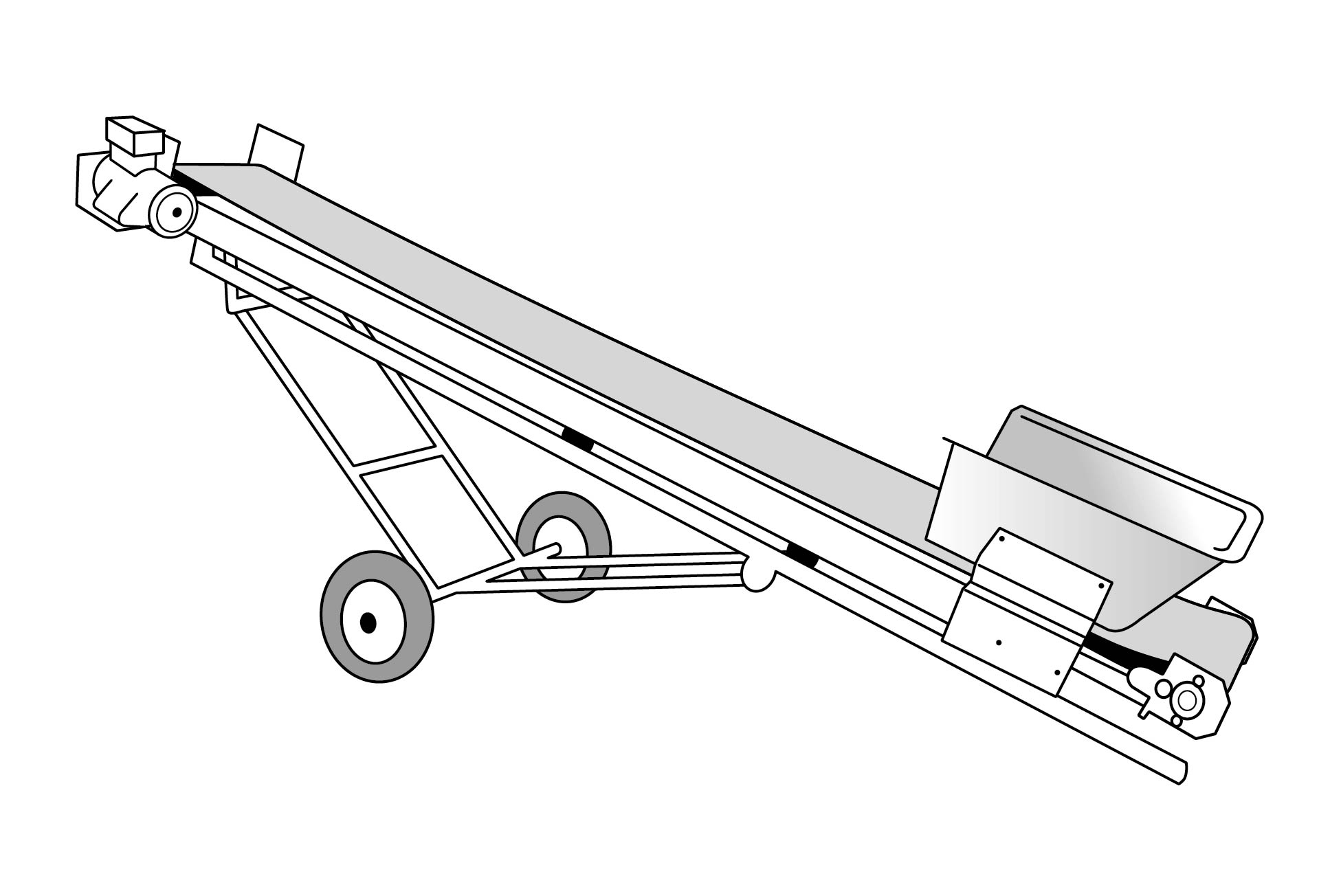
Protecting the environment
Storages do cost money, but costs vary depending on how elaborate you want the walls, floor or roof. There are several things to think about as you ponder whether to construct walls, floor or a roof.
Walls versus no walls
Some might wonder why storage walls are needed. Horse manure stacks well naturally because of the bedding in it, with side slopes about 30° — a 3-m vertical rise to a 5-m horizontal spread. However, runoff occurs from the sloped sides of the piles, whereas walls make the manure stack deeper, reducing runoff, as the walls force rainfall to soak into the pile. All things being equal, for two piles of manure with equal volume and height, one with walls requires less floor area than one without walls (Figure 8).
A pile without walls is difficult to shape to exactly fit a rectangular-shaped concrete pad — the most practical shape of pad to construct because of forming issues.
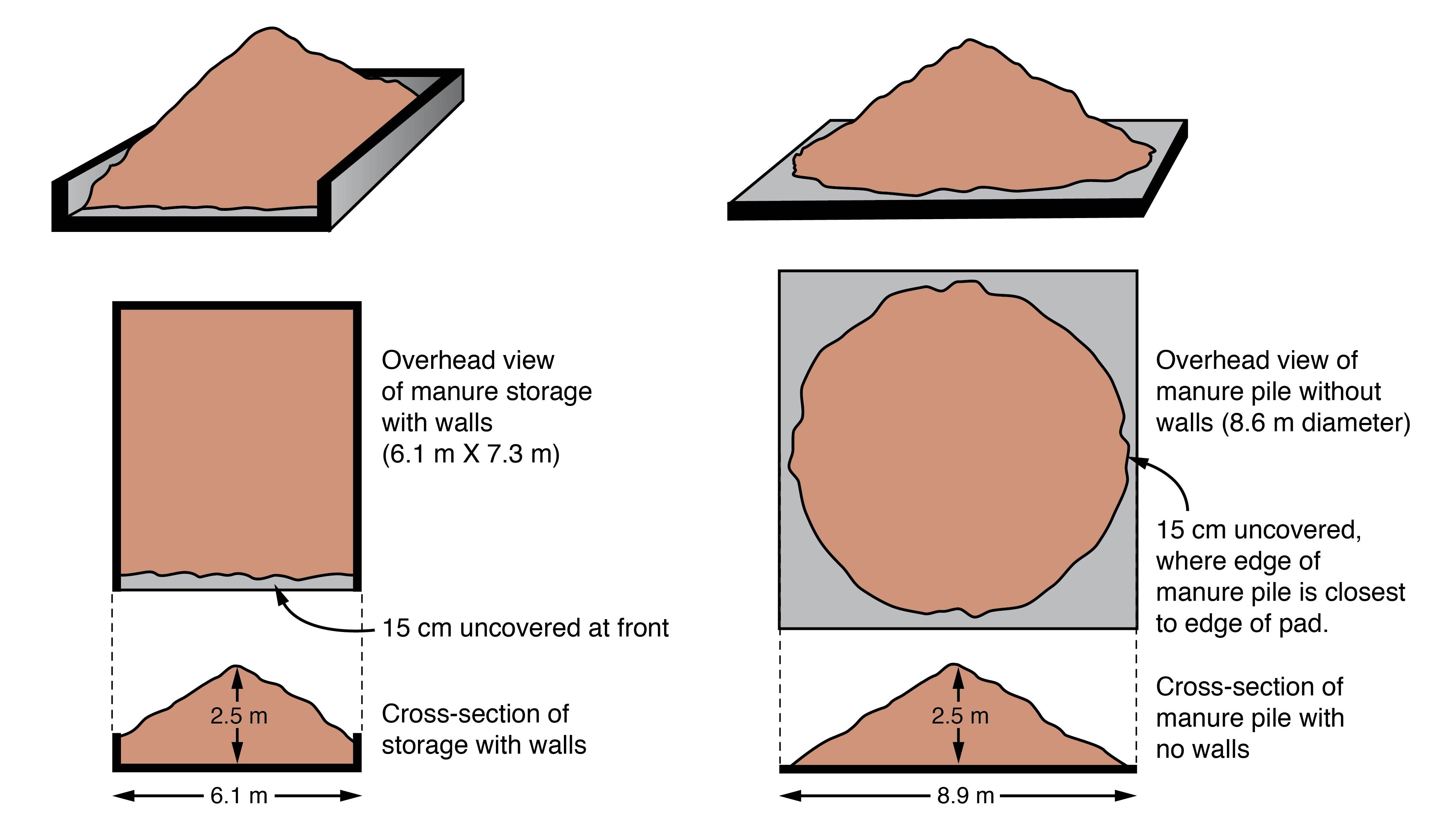
Table 2 compares piles with equal volumes and heights in storage with and without walls. The storage without walls assumes the pile is shaped like a cone stored on a square floor. Both storages extend 15 cm (6 in.) beyond the pile to help keep manure on the pad. Walls give something to push against, save cleanout time and help retain heat to promote composting.
The material used to construct the walls is a matter of choice, function, longevity and cost.
| Component | With walls | Without walls |
|---|---|---|
| Manure volume stored | 48.5 m3 (1,715 ft3) | 48.5 m3 (1,715 ft3) |
| Storage time | 240 days | 240 days |
| Manure depth | 2.5 m (8.1 ft) | 2.5 m (8.1 ft) |
| Storage outside: length | 7.3 m (24 ft) | 8.6-m (28.2-ft) wide round base on 8.9-m x 8.9-m (29.2-ft x 29.2-ft) floor |
| Storage outside: width | 6.1 m (20 ft) | 8.6-m (28.2-ft) wide round base on 8.9-m x 8.9-m (29.2-ft x 29.2-ft) floor |
| Uncovered floor concrete to prevent manure spillage off open storage sides | 15 cm (6 in.) (at open front) | 15 cm (6 in.) (beyond edge of circular pile) |
| Approximate exposed manure surface area | 46 m2 (495 ft2) | 68 m2 (732 ft2) |
| Approximate concrete needed | 10.9 m3 (14.3 yd3) floor & walls | 8.2 m3 (10.7 yd3) floor only |
Reinforced concrete (Figure 9) is durable and will withstand the abuse of weather, manure juices and pushing from the manure and equipment. Concrete blocks (Figure 10) are inexpensive but do not fit perfectly together and are difficult to manoeuvre. Wood walls (Figure 2) must be designed to withstand manure pressures and be made of pressure-treated wood.
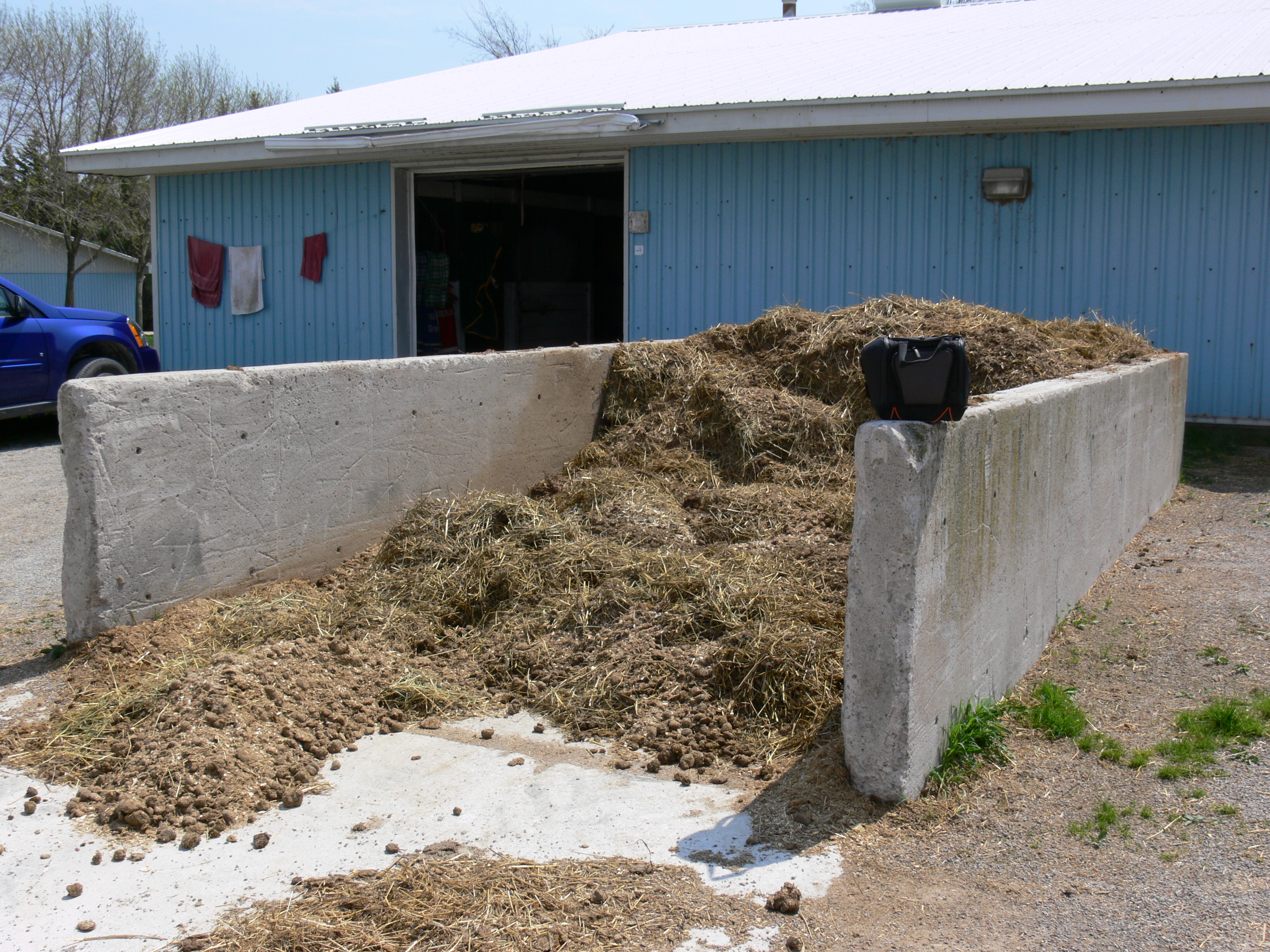
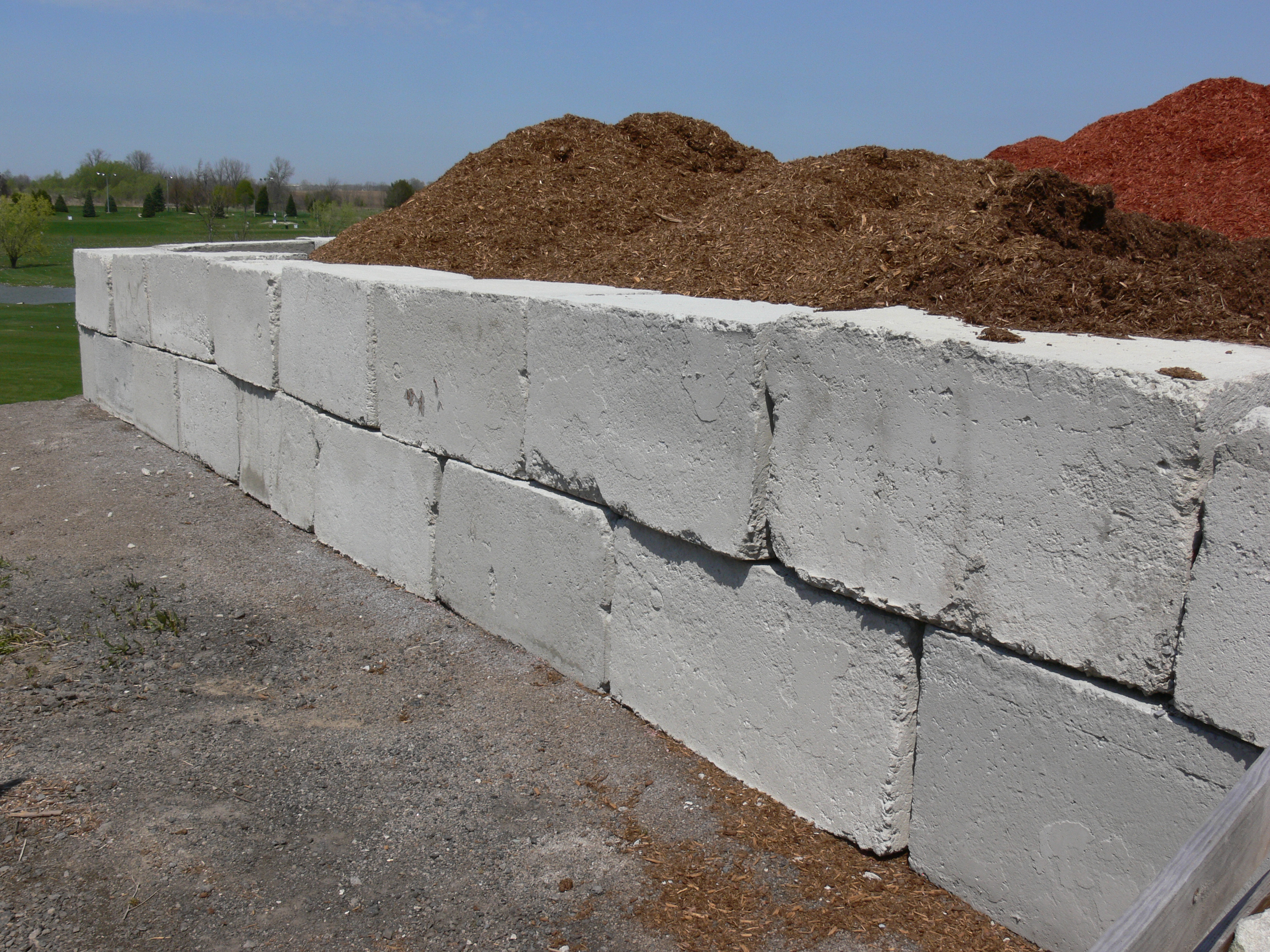
Floor versus no floor
It is easier to load and unload manure storages when there is a good concrete floor underneath. However, under the right conditions, an expensive permanent concrete floor just might not be necessary.
Farms covered under the Nutrient Management Act, 2002, constructing solid manure storages must use one of three types of floors:
- concrete (or equivalent)
- earth floor, 0.5 m (20 in.) of hydraulically secure soil
- earth floor, 0.5 m (20 in.) of hydrologic soil Type C or D soil, as long as the farm is <300 NU in size
The hydrologic soil type is based upon a soil’s rate of water intake after prolonged wetting
However, when handling manure on soil floors, take care that the floor does not get badly rutted. Where soil floors are permitted, an innovative way to provide some rutting protection is to install rubber matting (Figure 11).
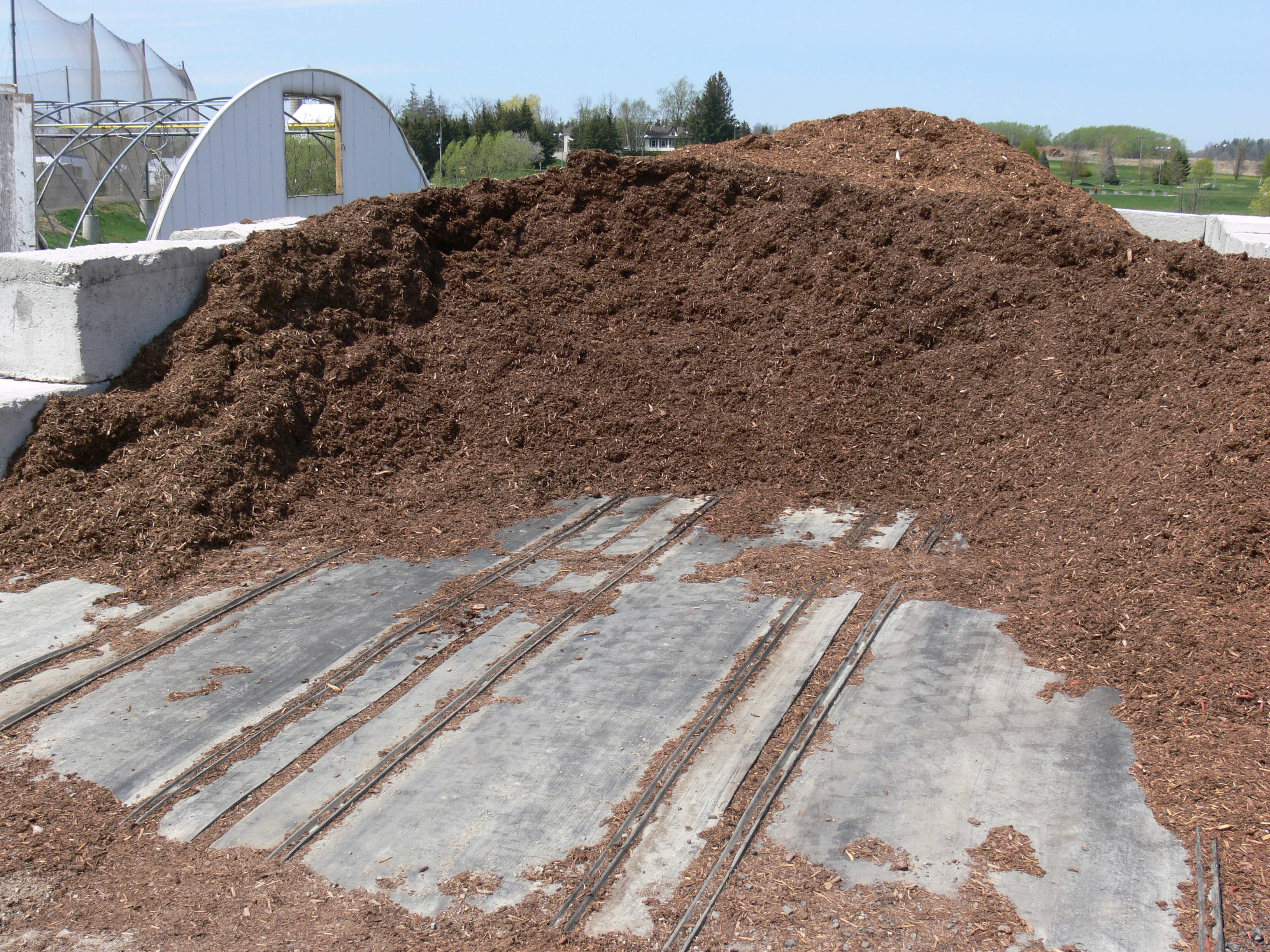
Roof versus no roof
Horse manure storages don’t need roofs, as the manure is dry, and there is little runoff. Roofed storages (Figure 12) likely need building permits.

Building your storage
To build manure storage for 10 horses like the one in Figures 5 and 9, with three walls, 1 m (3.25 ft) high, open to the front, with a flat concrete floor, you will likely need a building permit. This will phase you in under the regulations of the Nutrient Management Act.
Solid manure storage volumes are usually calculated as the product of storage length, width and height. However, this does not work for small storages, as there is considerable loss of storage volume at the open front because of the manure slope. Also, it is more difficult to store manure very deep as it can spill out over the walls when nearly full. Table 3 shows dimensions of a few small manure storages that satisfy a 240-day storage period.
| Number of horses | Outside width m (ft) | Outside length m (ft) | Manure depth m (ft) | Manure volume m3 (ft3) |
|---|---|---|---|---|
| 1 | 3.0 m (10 ft) | 4.3 m (14 ft) | 1.6 m (5.2 ft) | 9.7 m3 (343 ft3) |
| 5 | 6.1 m (20 ft) | 7.3 m (24 ft) | 2.5 m (8.1 ft) | 48.5 m3 (1,715 ft3) |
| 10 | 8.5 m (28 ft) | 9.1 m (30 ft) | 3.0 m (9.8 ft) | 97 m3 (3,430 ft3) |
Another requirement under the NMA is to provide a permanently vegetated flowpath to contain and treat any minimal runoff that might result from the pile. The flowpath is the distance over the ground that liquids have to flow from the storage before entering surface water or tile inlets. This does not have to be in a straight line. Figure 5 shows a meandering flowpath.
A permanently vegetated flowpath has a saucer shape and a healthy stand of vegetation to slow down any runoff from the storage and use up its nutrients. The NMA specifies the length of flowpath based on manure dry matter content. For horse manure 30% to <50% dry matter, use a 150-m (492‑ft) flowpath; for horse manure 50% or greater dry matter, use a 50-m (165-ft) flowpath. Most horse manure is 30%–50% dry matter.
The flowpath must be located on a minimum of 0.5 m (20 in.) of soil, no closer than:
- 3 m (10 ft) from a field tile drain
- 15 m (50 ft) from a drilled well
- 100 m (328 ft) from a municipal well
- 30 m (100 ft) from any other wells
Minimum distance separation (MDS) formula
The Minimum Distance Separation (MDS) II Formula determines minimum setbacks between new or expanded livestock facilities (such as horse barns or manure storages) and existing or approved development next door (such as a neighbouring house).
MDS II is triggered when a building permit is required, and the calculation of setbacks is done by the municipality. For more information, consult your Municipal Office.
This Factsheet was originally written by Hugh Fraser, P.Eng., Extension Agricultural Engineer, OMAFRA, Vineland (retired), and updated by Dan Ward, P.Eng., Agricultural Engineer, OMAFRA, Stratford, and Matt Wilson, Nutrient Management Team Lead, OMAFRA.
Footnotes
- footnote[1] Back to paragraph OMAFRA software Agrisuite Computer Program, 2017.
- footnote[2] Back to paragraph Soil Resource Group. Protecting Water Quality Through Improved Storage Methods for Poultry Manure. Final report for OMAFRA Health Futures Program. July 2002.
- footnote[3] Back to paragraph OMAFRA Publication 29, Drainage Guide for Ontario